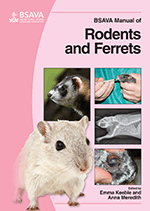
Full text loading...

The rodent species discussed here have a similar vascular configuration. Blood collection should be swift and preferably without sedation to minimize artefacts, though in many cases it may be necessary to anaesthetize the animal or use small restraint devices such as plastic syringe cases or small boxes. The total blood volume in normal healthy animals is approximately 7% of the body weight and 10% of this can safely be withdrawn for examination. Values for haematology and biochemistry have often been derived from laboratory animals and should be used a guide only. The haemogram may vary with age, sex, diet and husbandry conditions. A stress leucogram, associated with transport and handling, is likely in most species. The chapter considers Electrophoresis; Cytology and microbiology; Bacteriology; Dermatophytes; Serology; Viral infections and Urinalysis.
Rodents: clinical pathology, Page 1 of 1
< Previous page | Next page > /docserver/preview/fulltext/10.22233/9781905319565/9781905319565.4-1.gif

Full text loading...


